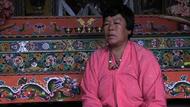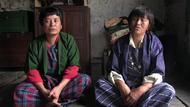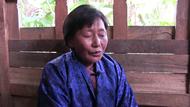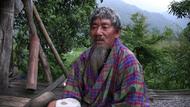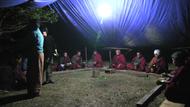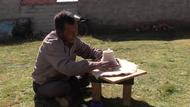Video Overview
Dawa Tsering explains the history of the stone carving trade in the area. The title also includes the display of various finished stone sculptures in Dawa Tsering's shop.
- Lhokha
- Chonggyé Khül
- Chonggyé
- སྐྱེས་ས་སྐྱེས་ཁུངས་འཕྱོངས་རྒྱས་རང་ཡིན། ས་ཆ་ད་གའི་མི་ཡིན། འཕྱོངས་རྒྱས་རྫོང་གི་གཡང་ཊི་བཟོ་གྲྭ་འདི་ད་ལྟ་བཙུགས་ནས་ད་ལྟ་བར་དུ་ང་འདའི་འགན་འཁུར་མི་སྣའི་བཟོ་ལྟ་བྱས། ཁྲང་ཀྲང་(Ch. 厂长)འདི་འདྲས་བྱས་ནས་བསྡད་ཡོད་ད་ལྟ། ད་ལྟའི་ངོས་ནས་ཁྲང་ཀྲང་ཡིན་པ་བྱས། འོ་འདི་འདྲས་ཡིན།I was born here in Chonggyé itself. I am the director of the jade stone carving business since it the company was started.
- གཡང་ཊི་འདིའི་ཡོང་ཁུངས་དང་འཕྱོངས་རྒྱས་ཀྱི་གཡང་ཊི་འདི་སྤྱི་ཚོགས་རྙིང་པའི་དུས་ལ་འདི་འདྲས་ཤིག་འདུག གཡང་ཊིའི་ཡོང་ས་ཡོང་ཁུངས་འདི།The history of jade mining in Chonggyé was there before us.
- འདི་སྔོན་ལ་འཕྱོངས་རྒྱས་ཀྱི་ཐང་པོ་ཆེ་ཤང་(Ch. 乡)། དེང་སང་བྱས་ན་ཐང་པོ་ཆེ་ཚུན་(村)ཟེར་གྱི་རེད། འདི་ལ་གཡང་ཊི་ཐང་ཀ་རེད། ཟེར་བྱས་དེ་སྔོན་ལ་སྤྱི་ཚོགས་རྙིང་པའི་དུས་ལ་བཟོ་ཡག་གི་ཐང་ཀ་བསྐོས་ཡག་གི་འདི་འདྲས་གཅིག་ལོ་རྒྱུས་ཐོག་འདི་འདྲས་ངོ་།Earlier, this area was known as Chonggyé Thangpoche township; nowadays, it is Thangpoche village. In the old days, Jade was mined and used chiefly for tangka painting.
- དེའི་རྗེས་ལ་ང་ཚོས་བཟོ་གྲྭ་འདི་བཙུགས་དུས་ལོ་རྒྱུས་འདི་འདྲས་ཤིག་ཡོད་པའི་རྗེས་ལ་ང་ཚོ་བཟོ་གྲྭ་འདི་གང་འདྲས་བཙུགས་དགོས་རེད་ཟེར་།We built the factory on that historical background.
- ལྟ་གཡང་ཊི་ཡོང་ཁུངས་དང་ས་ཆ་དེ་གང་འདྲ་ཡོད་མེད་མིག་ལྟ་དུས། འདིའི་རྗེས་ལ་ཤེལ་རགས་ཀྱི་རི་ལྡེབས་ཕར་འདི་བྱས་ཡོང་དུས་ལ་ཡུལ་ཟེར་གྱི་རེད། གཡང་ཊི་དེའི་དམིགས་ཡུལ་རྨང་གཞི་དེ་རེད་རྒྱ་སྐད་ནང་དུ་ལ་ཡུལ་ང་ཚོས་ཤན་དེའི་མིང་ལ་གཞིས་ཆགས་ཀྱི་མིང་དེ་ལ་ལ་ཡུལ་ཤངས་ཟེར་། འོ་འདི་བྱས་ཙང་གཡང་ཊི་དེ་འདི་ནས་འདོན་པའི་བཟོ་ལྟ་བྱས་སོང་།When we studied the source of jade stone, it was mine at the foothill of Shelrag mountain in Lhayul. It is where our village is located.
- འོ་འདི་ལ་ཡུལ་ཤངས་ནས་གཡང་ཊི་འདུ་སེ་ཐོན་ཤག ཐོན་ནས་ང་ཚོའི་བཟོ་གྲྭ་འདི་བཙུགས་ནས་ད་བར་ལོ་༢༢ཙམ་འགྲོ་གི་འདུགSo the jade was mined in Lhayul. Our company is 22 years old.
- ལོ་༢༢ནང་ལ་ལྟ་ང་ཚོ་བཟོ་གྲྭ་འདི་ཐོག་མར་གཡང་ཊིའི་འདི་འདྲས་ཀྱི་གཅིག་ནས་རང་བྱུང་གི་ཁོར་ཡུག་འདི་འདྲས་ཡོད་པ་གཅིག་ལ། སོ་སོས་ས་ཆ་འདི་ལ་གཡང་ཊིའི་རྡོ་དང་ཟུལ་ཅིང་གི་འདི་འདྲས་ཀྱི་ཉོ་ཡག་སོ་སོའི་མང་ཚོགས་ཀྱི་ཐོག་ནས་ཚུར་ཉོས། འདི་འདྲས་བྱས་ནས་ང་ཚོས་ཐོག་མར་བཟོ་གྲྭ་བཙུགས་དུས་རྒྱ་ཆུང་ཆུང་ཞེ་དྲགས་ཡོག་རེད།Since we have the resource here, we are capitalizing on that by mobilizing the local people.
- རྒྱ་ཆུང་ཆུང་བྱས་ནས། དངུལ་ཁང་ལ་བུ་ལོན་གཡར་ནས་༡༢,༠༠༠༠ཙམ་གཡར་ནས། ད་ལྟའི་ངོས་ནས་བཟོ་གྲྭ་འདི་ཁྲི་༥༠༠,༠༠༠ ནས་༦༠༠,༠༠༠ མ་རྩ་འདི་འདྲས་ཞིག་ཆགས་བྱས་འོ་འདུག་སེ་བྱུང་སོང་།We took a bank loan and borrowed 120,000 Yuan. Now it has a working capital of between 500,000 to 600,000 Yuan.
- འདུག་སེ་བྱས་ནས་ལྟ་བཟོ་གྲྭ་འདི་འཕེལ་རྒྱས་ཐོག་ནས་གཅིག་ནས་གུང་ཁྲན་ཏང་གི་སྲིད་ཇུས་བཟང་པོའི་འོག་ལ་ང་ཚོས་བཟོ་གྲྭ་འདི་ལ་གཅིག་ནས་མང་ཚོགས་ཀྱི་བཟོ་གྲྭའི་བཟོ་མི་ཡོངས་ཕྱུག་པོ་ཆགས་ཡག་གཅིག་དང་།Firstly, under the good policy of the Communist Party, the company developed over the years, and the employees got rich.
- གཉིས་ནས་རྒྱ་ཆེའི་ཞིང་འབྲོག་མང་ཚོགས་ཀྱིས་དབུལ་པོའི་ཁྱིམ་ཚང་ཡིན་ནའང་འདྲ། ཕྲན་བུའི་རོགས་རམ་འདི་འདྲས་བྱེད་ཡག་གི་ནུས་པ་འདི་འདྲས་ཐོན་བྱས་འདུག་སུ་བྱུང་སོང་ཞེས་འོ་ད་ག་ཡིན།Secondly, it was the result of efforts by the broad masses, consisting farmers and nomads, who had also received some government support for lifting them out of poverty.
- ལྟ་བཟོ་གྲྭ་འདི་བཙུགས་ནས་ལོ་༢༠ལྷག་ཙམ་ནང་བཟོ་མི་ཡིན་ན་བཟོ་གྲྭ་འདི་ལ་ཆ་བཞག་ནའི་མི་གྲངས་༡༧ཙམ། ལག་རྩལ་ཡོད་པ་རྦད་དེ་ཁོ་ར་བཟོ་ཐུབ་པ། སོ་སོས་རི་མོ་བྲིས་ཐུབ་པ།The factory is very two decades old, and currently 17 craftsmen. Everything is done here at the factory itself, including designing and production carved jade products.
- འོ་དངོས་སུ་ཕ་ནས་བཟོ་དུས་བཟོ་ཐུབ་པ་འདི་འདྲས་མི་གྲངས་༡༧ཙམ་ཞིག མི་ཁྱོན་ཡོངས་ལ་བཟོ་གྲྭ་འདི་ལ་ཉི་ཤུ་༢༥འོ་འདྲས་ཤིག་ཡོག་རེད།In total, the company employs 25 people, including those 17 craftsmen.
- དེའི་ནང་ཁུལ་ལ་དོ་དམ་གྱི་མི་སྣ་དེ་མི་ལྔ་ཙམ་འོ་འདུག་སེ་ཡོད། བཟོ་གྲྭ་འདིའི་ནང་ལ་ཅ་ལག་བཟོ་ཡག་གི་སྣ་ཁ་ལ་ཆ་བཞག་ན། སྣ་ག་དེ་༣༦༥འོ་འདི་འདྲས་ཤིག་དངོས་སུ་བཟོ་ཡག་གི་ཅ་ལག་འདི་འདྲས་བཟོ་ཐུབ་ཀྱི་ཡོད།From the total number of the employees, five people on the board of directors. Currently, we produce 365 different varieties of products.
- དེའི་ནང་ནས་ཆ་བཞག་ན་ཁ་ཤས་ཅ་ལག་བཟོ་དུས་ཀྱི་ཅ་ལག་བིན་ཚད་ལ་བཞག་ན་ལོ་གཅིག་ནང་ལ་ཆ་བཞག་ན་ཁྱོན་ཡོངས་ཀྱི་ཡོང་འབས་འདི་༡,༨༥༠,༠༠༠འོ་འདི་འདྲས་གཅིག་བཟོ་གི་ཡོད་བཱ།Regarding revenue, we have an annual gross income of about 1.85 million Yuan.
- འདིའི་ནང་ལོགས་ནས་ཁེ་འབབ་དེ་༤༠༠,༠༠༠འོ་འདི་འདྲས་གཅིག་བཟོ་གྱིས། འདུག་སེ་བྱས་ནས་ཅ་ལག་བིན་ཚད་ལ་ཆ་བཞག་ན་ད་ལྟའི་ངོས་ནས་མགྱོགས་པོ་མགྱོགས་པོ།And the net profit is about 400,000 Yuan.
- སྤུས་ཚད་ཐོག་ནས་སྤུས་ཚད། དེའི་སྔོན་གྱི་བཟོ་གྲྭ་བཙུགས་དུས་ཀྱི་ཆ་རྐྱེན་དེ། ད་ལྟ་ཆ་རྐྱེན་ཡག་ཏུ་ཕྱིན་པ་དང་། སོ་སོའི་ལག་རྩལ་ཡག་ཏུ་ཡིན་བྱས་སྤུས་ཚད་ཐོག་ཏིག་ཙམ་ཡག་གIn the early stage, we had limited facilities. Now everything improved, both the facilities and quality of the products.
- ལྟ་ཅ་ལག་ཐོག་ནས་ཆ་བཞག་ན་དངོས་གནས་ང་ཚོའི་རྒྱལ་ནང་ལ་ཆ་བཞག་ན། ང་ཚོ་རྒྱ་རིགས་བློ་མཐུན་གཟིགས་ཡག་ལ་ཆ་བཞག་ན།Our products can meet the demand of our Chinese comrades here in the country.
- སྒྲོག་དུང་ལ་སོགས་པ། སེམས་ཅན་ལོ་འཁོར་བཅུ་གཉིས་ལ་སོགས། དེ་འདྲས་ཀྱི་ཅ་ལག་འདི་འདྲས་བིན་ཡག་ཏིག་ཙམ་ཤུགས་ཆེ་ཡོང་།Jade bracelets and carving of the twelve zodiac symbols are high in demand.
- ང་ཚོ་བོད་ནང་ཁུལ་ལ་ཆ་བཞག་ན་ཇ་ཀར་དྲ་མི་དྲ་རྒྱ་ལ་སོགས་པ། གཞན་དག་གི་ཀར་ཡོལ་རིགས་མི་འདྲ་བ་སོགས་པ་རིགས་མི་འདྲ་བ།Here in Tibet, the Tibetans prefer the various type of bowls made we made here.
- དེས་མ་ཚད་ལྟ་སོ་སོའི་རི་མོ་བཀྲ་ཤིས་རྟགས་བརྒྱད་བརྒྱབ་བཟོ་ལྟ་འདི་འདྲས་དང་། འདི་འདྲས་ཨམ་ཅོག་འདོགས་ཡག་འདི་འདྲས་དང་། ལག་པར་འདོགས་ཡག་འདི་འདྲས་ལ་དགའ་པོ་ཞེ་དྲགས་བྱེད་ཀྱིས།In addition to that, they love jade caving of the eight auspicious symbols, and ornaments for the ears and hands.
- དེ་ནས་ལྟ་བལ་ཡུལ་གྱི་སྐུ་མགྲོན་རྣམ་པ་དགོས་ཡག་གི་ཅ་ལག་རིགས་ཆ་བཞག་པ་ཡིན་ན། ཅ་ལག་སྐེ་ལ་འདོགས་ཡག་དང་། ཨམ་ཅོག་འདོགས་ཡགདང་། ལག་པར་གྱོན་ཡག་འདི་འདྲས་སྒྲོག་དུང་དང་། ང་ཚོ་མི་འདྲ་བར་ཁོང་ཚོ་སྒྲོག་དུང་ཆེན་པོ་ཞིག་འོ་འདི་འདྲས་ཤིས་དགོས་མཁན་ཞིགThe Nepalese tourists like necklaces, earrings, and bracelets. Unlike Tibetans, they prefer larger sizes than us.
- རི་པིན་གྱི་སྐུ་མགྲོན་འདི་འདྲས་ལ་ཆ་བཞག་ན་ཁོང་རྣ་ཚོར་དགོས་ཡག་དེ། ང་ཚོས་བྱས་ན་རུས་སྦལ་ཟེར་བ་དེ་འདྲ། སེང་གེ་ཟེར་བ་བཟོ་ལྟ་འོ་འདི་འདྲས་ལྟ་ཟུལ་ཅིང་གྱི་ཇའུ་ཟེར་བ་སྤོ་ལོ་ཟེར་བ། ལག་པའི་ནང་རྩ་སྦྱོང་རྩེ་སྤོ་ལོ་འདི་འདྲས་ལ་དགའ་པོ་གནང་གིས། འོ་འདུག་བྱས་ཙང་ལྟ་ང་ཚོས་གཙོ་བོ་འགྲིམས་ཚད་ལོ་རེའི་ནང་ཆ་བཞག་ན།The Japanese visitors love to buy decoratives pieces like turtles, lion, ball, hand massage balls, etc.
- ང་ཚོ་གཙོ་བོ་ཅ་ལག་བཟོ་ཡག་གི་འདི་གས་ལ་ད་ལྟ་བིན་ཡག་གི་ཅ་ལག་འདི་གས་ལ་བརྟེན་ནས་ཨཱ་ནི་ཞོར་དུ་ང་ཚོས་བཟོ་ཡག་ཙག་ཙིག་དང་བཟོ་ཡག་བྱུང་བྱུང་ཆུང་ཙག་འདི་འདྲས་བཟོ་གི་ཡོད། འོ་འདུག་སེ་ཡིན།Besides those I mentioned earlier, we also create other products of different sizes.
 Loading ...
Loading ... 